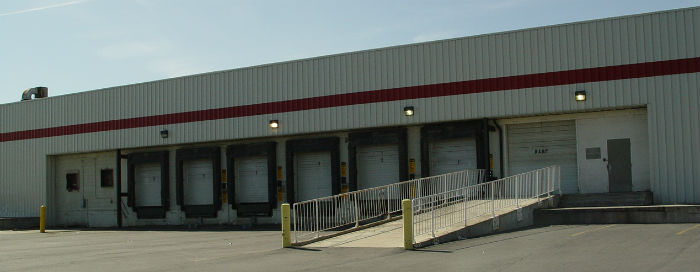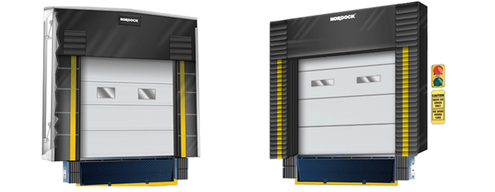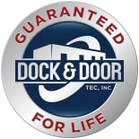|
In everyday life, there is a risk in just about everything we do. Most of that risk is so insignificant that we don’t even give it a thought. In a warehouse and especially at a loading dock the risk increases drastically. OSHA makes the following statement on their website, “loading docks can be dangerous places for forklifts, falls from a loading dock in a forklift can be fatal.”
With a combination of personnel, heavy equipment, moving product and trucks in the docks, the risks are endless. So, how do you assess risk and what do you do with that assessment? Webster Defines Risk as: risk noun \’risk\ : the possibility that something bad or unpleasant (such as injury or loss) will happen : someone or something that may cause something bad or unpleasant to happen : a person or thing that someone judges to be a good or bad choice for insurance, a loan, etc. It’s clear that working on a loading dock can be risky. Lots of heavy moving parts combined with foot traffic and moving trucks. Maybe the bigger questions are:
It is critical to understand the risk in your warehouse and how to mitigate that risk as much as possible. Part of risk mitigation is understanding the costs of death or injury versus the cost of equipment meant to limit the risk. I can tell you in no uncertain terms that the cost and maintenance of a truck restraint or a properly maintained dock leveler are far less costly than a serious injury or death. Have no doubt, mitigating or eliminating risk is attainable, it takes a commitment from management and staff. It takes a clear understanding of the risk and the expenses of doing everything or doing nothing. If you would like more information on risk management or mitigation please contact any of us at Dock & Door Tec. We will be happy to take a look at your facility, listen to you and provide you with a plan to help mitigate your risk. Since before the first loading dock was installed dock safety has been a concern. As the equipment got better, faster and heavier so too has the danger of working on a loading dock. We have all heard that safety is everyone’s responsibility but after seeing what I have seen on the docks, I question that old adage. I have seen fully loaded forklifts going far faster than they should, I have seen dock equipment ready to collapse being used. I have even seen my boss nearly crushed by a forklift.
So, who is really responsible to stop these mishaps and near misses? In the end, it is your reasonability to keep yourself safe first. You may say that it’s a self-centered act to think of yourself first but I contend that if everyone considered their personal safety first then everyone as a collective unit would be safer as a whole. It may be difficult to eliminate all loading dock mishaps but it is possible to minimize the damage to both personnel and equipment.
This is a very limited list and each facility has its own unique challenges, know your surroundings and keep yourself safe. Rick Hopkins Operations Manager, Dock & Door Tec To understand dock levelers we must first understand the purpose. A dock leveler is intended to act as a bridge to safely allow for the transfer of goods from a trailer to the building and vice versa.
To best determine the type of leveler needed it is important to gain a full understanding of your needs. Many factors should go into the decision, such as the volume of use, gross weight transferred, type of material handling equipment used (forklift, hand loading, pallet truck, conveyor, etc.), size of product handling, and building layout are just a few. Regarding cost, of course, the upfront cost is important but we see many paying less upfront (they really got a good deal!) but paying exponentially more over the life of the equipment due to a poor purchasing choice. Looking beyond the upfront cost and understanding the cost of ownership is very important. The other variable is safety, with the wide ranges and type of equipment available safety never has to be compromised. Operation types can be broken down into three basic types: mechanical, air and hydraulic. There are hybrids of these which are often a great choice, for example a hydraulic leveler with a mechanical lip will work great in many applications. Type of levelers:
Whether you are replacing existing equipment or designing a new facility it is important to keep your long terms needs front and center when selecting the right piece of equipment. Big Fans of Big Fans
We’re not talking about the fans who go crazy when you fulfill an order or create a new process. We’re talking about those really big ones that you may have seen somewhere. The proper name for these big fans are HVLS fans. A high-volume, low-speed fan (HVLS) is a large, commercial-grade fan often used to supplement heating and cooling systems. Unlike ordinary fans that span 36 to 52 inches, HVLS fans have diameters up to 24 feet. This bigger size allows them to move huge amounts of air while rotating at slow speeds. The blades of the fans are designed to create an enormous column of air that travels down to the floor and outward in all directions. This jet of air travels horizontally (much farther than residential fans), before flowing back up and reentering the fan. Benefits of an HVLS fan
There are many sizes and models of HVLS fans. You can even integrate some with solar power or centralized control centers. HVLS fans can provide immediate advantages for your warehouse, and their energy savings and efficiency-boosting abilities mean you can recoup your investment in a short amount of time. Check out this article from Hunter’s Senior VP, Jeff Chastian on why you need HVLS fans. To see how much your facility can benefit from our fans, contact us today. Whether you are replacing existing equipment or designing a new facility it is important to keep your long terms needs front and center when selecting the right piece of equipment. Recognize the importance of the loading dock The loading dock is so much more than a platform or entryway — it’s a pivotal part of the supply chain and should be treated as such. Some prefer to call it the Material Transfer Zone (MTZ), as it’s where the important exchange of finished products and raw materials occurs. During this transfer, goods are vulnerable to theft, fire, vandalism, and more. Know governmental requirements Depending on the types of materials you are transferring, your handling process may need to meet certain governmental requirements. Agencies such as the Federal Motor Carrier Safety Administration; Department of Homeland Security; U.S. Department of Agriculture’s Food Safety and Inspection Service; and the Food and Drug Administration all have certain guidelines that can affect your supply chain, including the MTZ. It’s important you become familiar with the various government initiatives and, if need be, modify your loading dock procedures. Scrutinize your facility from a criminal’s point of view Walk around your property and examine how easy it is to gain entry into your building. Are locks easily compromised? Are there gaps in or around your loading dock? Do you have a security system? If you realize your facility is less than secure, consider investing in an overhead door/vehicle restraint system that is connected to an electronic security system. When a trailer is released without permission or if the door is breached, an alarm will sound and alert you of any possible dangers. Upgrade dock door locks Most manually operated, overhead doors come with locks that are easily broken, making your plant susceptible to unauthorized entry, and standard slide locks eventually wear out and are useless if not replaced or repaired. Not to mention, these types of locks are often ineffective simply because workers forget to engage them. For better defense, ensure your overhead door is secure by installing an automatic lock-down security system. Use security gate In hot weather, it can be tempting to leave your dock door open to allow airflow, but a wide-open door simply acts as a welcome sign to unwanted visitors. Instead, of shutting the door completely and suffering through hot, unproductive conditions, think about putting in a steel folding security gate. It allows you to protect your warehouse from unauthorized entry while still allowing visibility and airflow. Also, you can make the dock area more comfortable by installing industrial-grade fans and air exchangers. Lockdown landing gear After a trailer is properly positioned against a dock door, it’s not uncommon for a truck driver to unhook his vehicle from the trailer and drive away. However, this poses a security risk at unmonitored docks, as someone could raise or lower the nose of the trailer to create a gap between the trailer and open dock door (a possible entry point). To prevent this problem, use heavy-duty locks on all trailer landing gear, which makes it impossible to move the trailer up or down. Consider using vertical storing hydraulic dock levelers There are many types of dock levelers and each has their benefits, but if security is of particular concern at your plant, you may want to use a vertical storing leveler since it allows both trailer and dock doors to remain closed until the trailer is safely connected to the dock and a seal is in place. With other types of levelers, the driver may need to open the trailer door prior to backing into the loading/unloading bay, which puts the cargo at risk for an indefinite amount of time. Use vehicle restraints Vehicle restraints keep the trailer from separating from the dock during loading and unloading, and while they are commonly used for worker safety, they are also useful for preventing trailer hijacking. Also, if they are integrated with your dock’s alarm system, a signal will sound if a trailer is unexpectedly released. Install seals and shelters Dock seals and shelters are most commonly used for energy efficiency and to guard the warehouse from outside elements, but because they close gaps, they also reduce pilferage and some models can even protect against fire. Always follow a loading/unloading process Whenever there are variations in your loading/unloading process, the potential for error and mishaps is greater. An effective way to sequence your operation is to use an electronic dock control system that integrates all your equipment (leveler, restraints, door, shelter, and security) into one streamlined procedure. Such a system ensures all components interlock correctly and prevents damage, which helps to reduce failures and gaps that can lead to unwanted entry into your building.
If you’re unsure if your loading dock is properly secure, ask a professional loading dock company, such as Dock & Door Tec, to inspect your facility. It’s always best to take preventative measures than to deal with the aftermath of a security breach. |
AuthorVarious. Archives
August 2023
Categories
All
|
- Home
- About
- Career Opportunities
- Services
-
Equipment
- Dock Locks (Truck Restraints) >
- Fans & In-Plant Equipment >
-
Industrial / Commercial Doors
>
- High Speed Fabric Doors
- Security High Speed
- Rubber Doors
- Fire Door
- Rolling Steel
- Impactable Dock Doors
- Cooler / Freezer
- Fabric Roll-Up
- Impact / Traffic / Bump
- Overhead / Sectional Doors
- Operators / Activation
- Air Curtains / Screen & Bug Doors
- Strip Doors
- Door Entrapment Protection
- Door Protection
- Overhead Door Upgrades
- Loading Dock Levelers & Lifts >
- Loading Dock Seals & Shelters >
- OEM & Aftermarket Parts
- Safety / Energy / Security / Employee Comfort >
- Yeti Snow Removal
- Markets
- Blog
- Contact
Dock & Door Tec
Serving Minnesota, Wisconsin, Iowa, North Dakota & South Dakota
Serving Minnesota, Wisconsin, Iowa, North Dakota & South Dakota




 RSS Feed
RSS Feed
